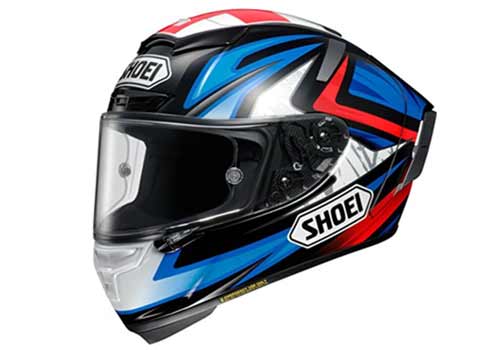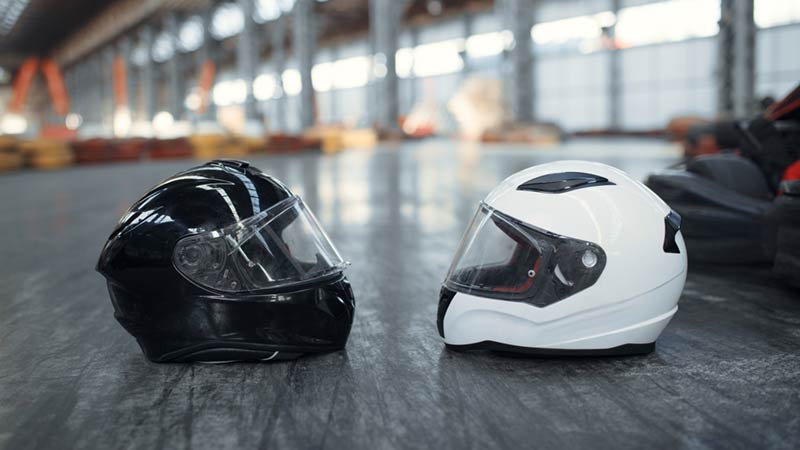When it comes to motorsports, it’s extremely important to be well-protected at all times, as safety should always be the primary focus. While all helmets are designed to protect the head from injury, not all types of motorsport helmets are the same.
There are key differences between go-kart helmets and motorcycle helmets. Go-kart racing helmets are Snell K certified (e.g. Snell K2020) , whereas motorcycle helmets are Snell M certified (e.g. Snell M2020). In summary, below are the main differences and similarities between both helmets:
- Certification (Snell K vs Snell M)
- Ventilation (both helmets have vents)
- Testing (both helmets have different testing standards)
- Design (both helmets have different shapes)
- Features (some go-kart helmets have HANS support – Snell SA helmets)
- Aerodynamics (some motorcycle helmets have rear spoilers)
Go-kart helmets, which are more similar to auto racing helmets, have different impact tests, design, features and aerodynamics compared to motorcycle helmets. Let’s explore these differences in more detail.
Similarities and Differences Between Go-Kart Helmets and Motorcycle Helmets
Both go-kart and motorcycle helmets have one primary objective, which is to protect the driver’s/rider’s head at all costs. While they may appear to have a similar appearance, there are several features that set them apart.
Certification
Go-kart racing helmets are Snell K (karting) certified and the latest certification standard is Snell K2020. Previous versions include (K2015 and K2010). These types of helmets have similar properties to auto racing helmets, which are Snell SA (special application) certified. The only difference is that Snell K helmets don’t have a fire rating.
On the other hand, motorcycle helmets are Snell M (motorcycle) certified and the latest standard is Snell M2020. Previous versions include (M2015 and M2010). While Snell M and Snell K certified helmets go through similar tests, they have different testing parameters. They also have different design and application elements, and therefore fall under a different Snell certification.


Testing
Both go-kart helmets and motorcycle helmets go through rigorous helmet testing before they are officially certified by the Snell Foundation. Snell outlines that their tests intend to measure the four most common protective properties of helmets:
- Impact Management – how it fares against collisions with objects
- Positional Stability – how well the helmet stays on the head
- Retention System Strength – how well the helmet straps hold
- Extent of Protection – how well the overall head is protected
To ensure that all helmet properties are measured as accurately and as effectively as possible, they go through multiple tests. Below is a list of these tests:
- Impact Test
- Positional Stability Test
- Dynamic Retention Test
- Chin Bar Rigidity Test
- Shell Penetration Test
- Face Shield Penetration Test
- Frontal Head Restraint Test
- Chin Bar Impact Test
While rigid testing is required for both Snell M and Snell K helmets, each helmet type needs to meet different requirements. This is because go-kart and motorcycle racers are exposed to different risks, as the nature of both motorsports is different.
Motorcycle riders and go-kart drivers have different racing positions. The helmet would also have different impact angles and impact velocity. All of these factors have to be considered in the tests to ensure that every aspect of safety is covered.
For example, both Snell SA and K helmets have multi-impact testing for roll bars, whereas motorcycle helmets do not – as there aren’t any roll bars on motorcycles, but on off-road go-karts. Therefore, the K and M helmet types go through similar tests, with varying parameters and requirements.
Here is a list of the tests conducted for Snell M, K and SA helmets.
| Snell SA | Snell K | Snell M | |
|---|---|---|---|
| Impact Test | Yes | Yes | Yes |
| Positional Stability Test | Yes | Yes | Yes |
| Dynamic Retention Test | Yes | Yes | Yes |
| Chin Bar Rigidity Test | Yes | Yes | Yes |
| Shell Penetration Test | Yes | Yes | Yes |
| Face Shield Penetration Test | Yes | Yes | Yes |
| Flame Resistance Test | Yes | No | No |
| Frontal Head Restraint Test | Yes | Yes | Yes |
| Chin Bar Impact Test | Yes | Yes | Yes |
- More Information: Snell Testing Guide
Design
Apart from certification and testing differences, motorcycle and go-kart helmets also have a different application. This means they have different designs, features and aerodynamics.
As far as design goes, it’s important to note that the rider/driver positions between both motorsports are very different. While go-kart racers find themselves in an upright seated position, motorcycle racers keep their body as perpendicular to the motorcycle as possible.


As you can see in the images above, the helmet position and angles are very different. While go-kart racing helmets tend to have a more rounded shape and a flat position, motorcycle racing helmets have an angulated design to account for the riding position.
Features
While both helmets feature ventilation ports for cooling and air circulation, motorcycle eye ports tend to be larger. This is also reflected in the Snell K and Snell M certification requirements, accordingly.
Helmets that are suitable for go-kart racing tend to be either Snell SA or K certified and feature threaded inserts to support Head and Neck safety devices (HANS). While this may not be needed in karting, these helmets contain similar features to auto racing helmets. On the other hand, motorcycle helmets do have any HANS support.
Aerodynamics
Both motorcycle and go-kart helmets feature aerodynamic designs and promote efficient airflow around the helmet. However, you’ll notice subtle differences in the shape of these helmets, as motorcycle and go-kart racers are seated differently.
While go-kart racing helmets feature a more rounded helmet design, motorcycle helmets tend to have sharper edges with an elongated rear section.
Certain motorcycle racing helmets also have rear spoilers, which help to reduce helmet lift and facilitate easier body position changes. Rear spoilers are not seen on go-kart helmets as the go-kart chassis itself is aerodynamically optimized.

